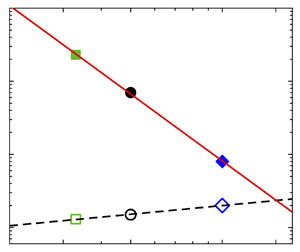Article contents
Universal scaling of temperature variance in Rayleigh–Bénard convection near the transition to the ultimate state
Published online by Cambridge University Press: 22 November 2021
Abstract

We report measurements of the temperature frequency spectra  $P(\,f, z, r)$, the variance
$P(\,f, z, r)$, the variance  $\sigma ^2(z,r)$ and the Nusselt number
$\sigma ^2(z,r)$ and the Nusselt number  $Nu$ in turbulent Rayleigh–Bénard convection (RBC) over the Rayleigh number range
$Nu$ in turbulent Rayleigh–Bénard convection (RBC) over the Rayleigh number range  $4\times 10^{11} \underset{\smash{\scriptscriptstyle\thicksim}} { < } Ra \underset{\smash{\scriptscriptstyle\thicksim}} { < } 5\times 10^{15}$ and for a Prandtl number
$4\times 10^{11} \underset{\smash{\scriptscriptstyle\thicksim}} { < } Ra \underset{\smash{\scriptscriptstyle\thicksim}} { < } 5\times 10^{15}$ and for a Prandtl number  $Pr \simeq ~0.8$ (
$Pr \simeq ~0.8$ ( $z$ is the vertical distance from the bottom plate and
$z$ is the vertical distance from the bottom plate and  $r$ is the radial position). Three RBC samples with diameter
$r$ is the radial position). Three RBC samples with diameter  $D = 1.12$ m yet different aspect ratios
$D = 1.12$ m yet different aspect ratios  $\varGamma \equiv D/L = 1.00$,
$\varGamma \equiv D/L = 1.00$,  $0.50$ and
$0.50$ and  $0.33$ (
$0.33$ ( $L$ is the sample height) were used. In each sample, the results for
$L$ is the sample height) were used. In each sample, the results for  $\sigma ^2/\varDelta ^2$ (
$\sigma ^2/\varDelta ^2$ ( $\varDelta$ is the applied temperature difference) in the classical state over the range
$\varDelta$ is the applied temperature difference) in the classical state over the range  $0.018 \underset{\smash{\scriptscriptstyle\thicksim}} { < } z/L \underset{\smash{\scriptscriptstyle\thicksim}} { < } 0.5$ can be collapsed onto a single curve, independent of
$0.018 \underset{\smash{\scriptscriptstyle\thicksim}} { < } z/L \underset{\smash{\scriptscriptstyle\thicksim}} { < } 0.5$ can be collapsed onto a single curve, independent of  $Ra$, by normalizing the distance
$Ra$, by normalizing the distance  $z$ by the thermal boundary layer thickness
$z$ by the thermal boundary layer thickness  $\lambda = L/(2 Nu)$. One can derive the equation
$\lambda = L/(2 Nu)$. One can derive the equation  $\sigma ^2/\varDelta ^2 = c_1\times \ln (z/\lambda )+c_2+c_3(z/\lambda )^{-0.5}$ from the observed
$\sigma ^2/\varDelta ^2 = c_1\times \ln (z/\lambda )+c_2+c_3(z/\lambda )^{-0.5}$ from the observed  $f^{-1}$ scaling of the temperature frequency spectrum. It fits the collapsed
$f^{-1}$ scaling of the temperature frequency spectrum. It fits the collapsed  $\sigma ^2(z/\lambda )$ data in the classical state over the large range
$\sigma ^2(z/\lambda )$ data in the classical state over the large range  $20 \underset{\smash{\scriptscriptstyle\thicksim}} { < } z/\lambda \underset{\smash{\scriptscriptstyle\thicksim}} { < } 10^4$. In the ultimate state (
$20 \underset{\smash{\scriptscriptstyle\thicksim}} { < } z/\lambda \underset{\smash{\scriptscriptstyle\thicksim}} { < } 10^4$. In the ultimate state ( $Ra \underset{\smash{\scriptscriptstyle\thicksim}} { > } Ra^*_2$) the data can be collapsed only when an adjustable parameter
$Ra \underset{\smash{\scriptscriptstyle\thicksim}} { > } Ra^*_2$) the data can be collapsed only when an adjustable parameter  $\tilde \lambda = L/(2 \widetilde {Nu})$ is used to replace
$\tilde \lambda = L/(2 \widetilde {Nu})$ is used to replace  $\lambda$. The values of
$\lambda$. The values of  $\widetilde {Nu}$ are larger by about 10 % than the experimentally measured
$\widetilde {Nu}$ are larger by about 10 % than the experimentally measured  $Nu$ but follow the predicted
$Nu$ but follow the predicted  $Ra$ dependence of
$Ra$ dependence of  $Nu$ for the ultimate RBC regime. The data for both the global heat transport and the local temperature fluctuations reveal the ultimate-state transitions at
$Nu$ for the ultimate RBC regime. The data for both the global heat transport and the local temperature fluctuations reveal the ultimate-state transitions at  $Ra^*_2(\varGamma )$. They yield
$Ra^*_2(\varGamma )$. They yield  $Ra^*_2 \propto \varGamma ^{-3.0}$ in the studied
$Ra^*_2 \propto \varGamma ^{-3.0}$ in the studied  $\varGamma$ range.
$\varGamma$ range.
Information
- Type
- JFM Papers
- Information
- Copyright
- © The Author(s), 2021. Published by Cambridge University Press
References
REFERENCES
- 12
- Cited by


